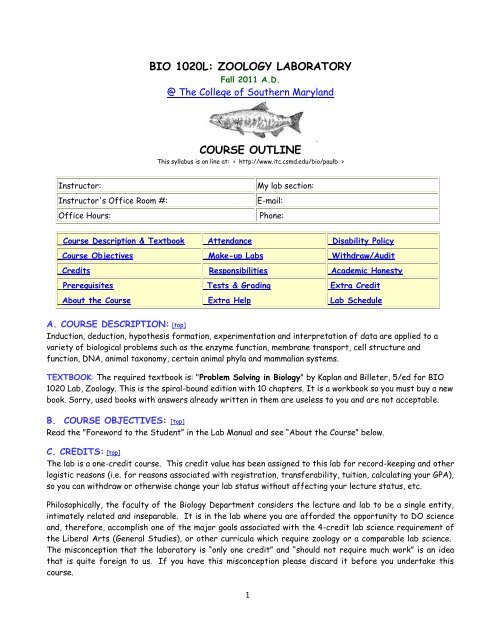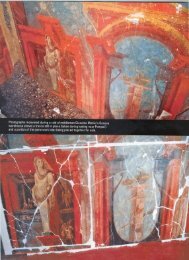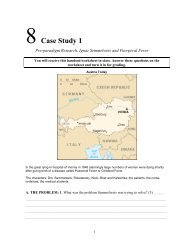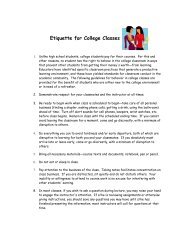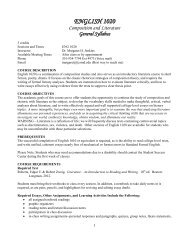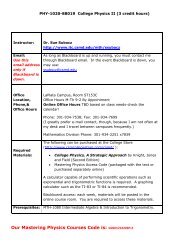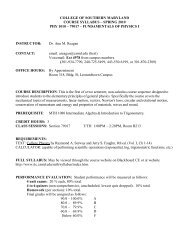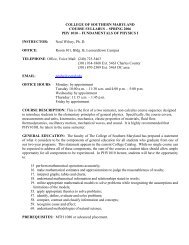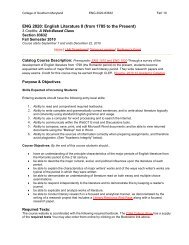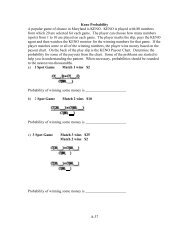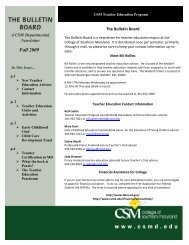bio 1020l: zoology laboratory course outline - Distance Learning ...
bio 1020l: zoology laboratory course outline - Distance Learning ...
bio 1020l: zoology laboratory course outline - Distance Learning ...
You also want an ePaper? Increase the reach of your titles
YUMPU automatically turns print PDFs into web optimized ePapers that Google loves.
BIO 1020L: ZOOLOGY LABORATORY<br />
Fall 2011 A.D.<br />
@ The College of Southern Maryland<br />
COURSE OUTLINE<br />
This syllabus is on line at: < http://www.itc.csmd.edu/<strong>bio</strong>/paulb ><br />
Instructor:<br />
Instructor's Office Room #:<br />
Office Hours:<br />
My lab section:<br />
E-mail:<br />
Phone:<br />
A. Course Description & Textbook F. Attendance K. Disability Policy<br />
B. Course Objectives G. Make-up Labs L. Withdraw/Audit<br />
C. Credits H. Responsibilities M. Academic Honesty<br />
D. Prerequisites I. Tests & Grading N. Extra Credit<br />
E. About the Course J. Extra Help O. Lab Schedule<br />
A. COURSE DESCRIPTION: [top]<br />
Induction, deduction, hypothesis formation, experimentation and interpretation of data are applied to a<br />
variety of <strong>bio</strong>logical problems such as the enzyme function, membrane transport, cell structure and<br />
function, DNA, animal taxonomy, certain animal phyla and mammalian systems.<br />
TEXTBOOK: The required textbook is: "Problem Solving in Biology" by Kaplan and Billeter, 5/ed for BIO<br />
1020 Lab, Zoology. This is the spiral-bound edition with 10 chapters. It is a workbook so you must buy a new<br />
book. Sorry, used books with answers already written in them are useless to you and are not acceptable.<br />
B. COURSE OBJECTIVES: [top]<br />
Read the "Foreword to the Student” in the Lab Manual and see “About the Course” below.<br />
C. CREDITS: [top]<br />
The lab is a one-credit <strong>course</strong>. This credit value has been assigned to this lab for record-keeping and other<br />
logistic reasons (i.e. for reasons associated with registration, transferability, tuition, calculating your GPA),<br />
so you can withdraw or otherwise change your lab status without affecting your lecture status, etc.<br />
Philosophically, the faculty of the Biology Department considers the lecture and lab to be a single entity,<br />
intimately related and inseparable. It is in the lab where you are afforded the opportunity to DO science<br />
and, therefore, accomplish one of the major goals associated with the 4-credit lab science requirement of<br />
the Liberal Arts (General Studies), or other curricula which require <strong>zoology</strong> or a comparable lab science.<br />
The misconception that the <strong>laboratory</strong> is “only one credit” and “should not require much work” is an idea<br />
that is quite foreign to us. If you have this misconception please discard it before you undertake this<br />
<strong>course</strong>.<br />
1
D. PREREQUISITES: [top]<br />
BIO 1020 lecture must be taken concurrently or in a previous semester.<br />
E. ABOUT THE COURSE - GOALS, OBJECTIVES, PHILOSOPHY, ETC.: [top]<br />
Most students in <strong>zoology</strong> lab are not science majors. For many of you, this is the only lab science you will<br />
take in college. In other words, for some of you this is your FIRST college lab science <strong>course</strong>, while for<br />
most, this is (also) your LAST college lab science <strong>course</strong>.<br />
The faculty of this college (and almost all other colleges) does not require students to take <strong>zoology</strong>, but we<br />
do require that you take at least one lab science <strong>course</strong> (among other requirements) to graduate. You may<br />
choose almost any 4-credit natural science <strong>course</strong> offered at almost any accredited college or university,<br />
e.g. chemistry, botany, physics, geology, astronomy, etc., or you may take, as you have chosen -- <strong>zoology</strong>.<br />
As part of an overall college education, it is a role of the lab science <strong>course</strong> to elucidate the nature of<br />
empirical* investigation that characterizes ALL science. Although science is sometimes defined as a body<br />
of publicly verifiable fact, a scientist is more apt to emphasize the inquiry by which these facts are<br />
discovered. In other words, <strong>zoology</strong> is not just the facts published in your textbook or other science<br />
books, journals, reports etc., it is also the processes used to discover those facts. An understanding of<br />
both the FACTS OF SCIENCE and the PROCESS OF SCIENCE is important in this <strong>course</strong>. It is equally<br />
important that we understand HOW things are known in science as it is WHAT things are known in science.<br />
An important goal of the introductory lab science <strong>course</strong>, be it <strong>bio</strong>logy, chemistry, geology, physics or<br />
astronomy, is to allow the student to explore, evaluate and consider the epistemology of science. That is,<br />
to wrestle with the basis of science's methods and the grounds of its knowledge, especially with reference<br />
to the limits of investigation and the validity of conclusions. By carefully studying science, any science, the<br />
lab <strong>course</strong> can make a student a better observer, a more careful and precise thinker, and a more deliberate<br />
problem solver. To a large measure, that's what a college education is all about.<br />
The "Foreword to the Student" in the lab manual has a further introduction to the nature of this lab<br />
<strong>course</strong>. The Biology Department welcomes you. We urge you to work hard, grapple with each problems<br />
presented, participate fully in your education, and earn the highest grade possible consistent with your<br />
abilities and the priority you place on your college education.<br />
F. ATTENDANCE: [top]<br />
Because of its nature, attendance in a lab <strong>course</strong> is mandatory. We value your participation and interaction,<br />
and consider your physical presence in the lab to the minimum commitment you can make to this <strong>course</strong>. I<br />
strongly urge you to avoid unnecessary absences.<br />
Each lab you miss and don't make up WILL LOWER YOUR FINAL GRADE BY FIVE (5) POINTS. IF YOU<br />
MISS MORE THAN THREE (3) LABS, YOU WILL BE ASKED TO WITHDRAW AND RETAKE THE COURSE<br />
IN A LATER SEMESTER WHEN YOU D0 HAVE SUFFICIENT TIME TO PARTICIPATE; IF THE<br />
WITHDRAWAL DATE HAS PASSED YOU WILL AUTOMATICALLY RECEIVE A GRADE OF “FX”.<br />
If you must miss a lab due to extraordinary circumstances, you may make it up during another scheduled<br />
section (see below). You must obtain prior permission from another instructor to make up a lab in their<br />
class. YOU are responsible to have your own instructor notified when you make up a lab with a different<br />
instructor so you are not considered absent. Notification forms are available in the lab for this purpose.<br />
2
G. LAB SCHEDULE FOR FALL 2011 [top]<br />
A) Tue 10:00-11:50a (Prof Billeter) Sect. 91740 LAPLATA ST-225 D) Thu 10:00-11:50 (Prof Morris) Sect. 91061 LAPLATA ST-225<br />
B) Tue 12:30-2:20p (Prof Billeter) Sect. 91739 LAPLATA ST-225 E) Fri 12:30p-2:20p (Prof Alston) Sect. 91016 LAPLATA ST-225<br />
C) Wed 12:30p-2:20p (Prof Billeter) Sect. 91251 LAPLATA ST-225 F) Sat 12:30p-2:20p (Prof Rizo) Sect. 90995 LAPLATA ST-225<br />
G) Thu 7:15-9:05p (Prof Morris) Sect. 87043 LEONARDTWN B-203 H) Tue 7:15-9:05p (Prof. Crocker) Sect. 91738 PR. FRED. PFA218<br />
I) Wed 11:30a-1:20p (Prof. Crocker) Sect. 91253 PR. FRED. PFA218<br />
H. RESPONSIBILITIES OF THE STUDENT: [top]<br />
1. Read the “Foreword” in the lab manual.<br />
2. Study each lab BEFORE coming to class by reading the "Preliminary" and/or "Introductory Information." (up<br />
to the pen icon ). Be familiar with the problem to be solved in each exercise. You must come to lab<br />
prepared! There may be a short quiz at the beginning of lab based on the preliminary information.<br />
3. Turn in each lab assignment as directed by your instructor. LATE ASSIGNMENTS WILL NOT BE<br />
ACCEPTED.<br />
4. In some cases, you will find it helpful (if not necessary) to devote some extra time outside of class to the<br />
study of the problems presented during the lab period. The schedule of classes for Room ST-225 will be<br />
posted near the door. You are encouraged to come to the lab for individual or group study during your free<br />
time. (This is particularly important for Labs 2 and 3.)<br />
5. YOU are responsible for the proper care of microscopes, keeping the lab clean, and returning materials to<br />
their proper places. Your cooperation in this matter will be helpful to me, the lab assistants, and other<br />
students who use the lab.<br />
6. If your lab does not meet due to a holiday, and unscheduled college closing, or if you must miss a lab for a<br />
legitimate reason, YOU are responsible to make up the lab during one of the other nine lab sections unless<br />
otherwise informed by your instructor.<br />
7. NO CHILDREN OR OTHER UNAUTHORIZED GUESTS ARE ALLOWED IN CLASSROOMS OR LABS. YOU<br />
MUST BE ENROLLED IN BIO 1020L TO ATTEND THE LAB. NO EXCEPTIONS.<br />
I. TESTS & GRADING: [top]<br />
Your final grade in <strong>zoology</strong> lab will be based on:<br />
1. Two written exams.<br />
2. The average of your graded lab exercises and quizzes.<br />
3. The work in your lab book.<br />
4. Any optional extra credit you choose to do.<br />
The two Hour Exams AND the lab exercise/quiz average are each worth 33.3% (1/3) of your final grade.<br />
Your lab book will be collected and evaluated on the two exam days. The instructor’s evaluation of your lab<br />
book will add or subtract -5 to +5 points to your lab exam grade.<br />
Extra Credit activities can earn 0-10 POINTS. These will be added directly to your final average.<br />
MAKE-UP EXAMS:<br />
1. For valid reasons (i.e., hospital stay, emergencies, etc.), a student may be excused from taking an exam at<br />
the scheduled time. In order to do this, the student must discuss with the instructor the reason for being<br />
excused, obtain permission, and make arrangements to take the exam before or after the scheduled time.<br />
3<br />
>>>
2. If a student fails to take an exam at the scheduled time without permission, s/he MUST present a<br />
written excuse (i.e., doctor's note, etc.). In this case, the student MUST make arrangements to take the<br />
exam WITHIN ONE WEEK of the originally scheduled time. IF THE STUDENT FAILS TO FOLLOW THIS<br />
PROCEDURE, S/HE WILL RECEIVE A GRADE OF ZERO (0) FOR THAT EXAM.<br />
GRADING SCALE: 90-100% = A 80-89% = B 70-79% = C 60-69% = D >><br />
4
Students wishing to learn more and/or perhaps earn a higher grade in the <strong>course</strong> may do so via extra<br />
credit. There are two extra credit options 1) viewing and reporting on additional TED Lectures 2) doing a<br />
book report.<br />
EXTRA CREDIT ACTIVITIES ARE OPTIONAL AND YOUR FINAL GRADE WILL NOT BE AFFECTED IF<br />
YOU DO NOT DO THEM. You may earn up to 20 points total of extra credit but you may only use a<br />
maximum of 10 in the lecture and 10 in the lab. You may not increase you grade in lecture or lab by more<br />
than 1 (one) Letter-Grade via extra credit; i.e. it’s possible to go from C to B with extra credit but not<br />
from C to A.<br />
EXTRA CREDIT POINTS MAY BE ADDED TO YOUR LECTURE OR LAB GRADE OR PARTITIONED<br />
BETWEEN BOTH. FOR EXAMPLE, IF YOU EARN 8 POINTS, YOU MAY ADD ALL 8 TO LECTURE, ALL 8<br />
TO LAB OR SPLIT THEM UP TO YOUR BEST ADVANTAGE. You will turn in your extra credit to your<br />
lecture professor but if you have different professor for lab, it is your responsibility to indicate to the<br />
lecture professor to transfer leftover points to the lab instructor. (e.g. if you have a final avg of 77 in<br />
lecture plus 9 points of extra credit, the lecture professor will use 3 points to raise your 77(C) to an 80 (B)<br />
and send the leftover 6 points to lab in case they help you there!<br />
If you intend to earn extra credit you must get started early (in the first week of class would be nice).<br />
EXTRA CREDIT OPTION 1: BOOK REPORT (0-10 Points)<br />
There are three books available for book reports in Zoology this semester. You can get them in the CSM<br />
Bookstore or order them at Amazon.com.<br />
1. Your Inner Fish: A Journey Into the 3.5 Billion-Year History of the Human Body by Neil Shubin.<br />
2. Stiff: The Curious Lives of Human Cadavers by Mary Roach<br />
3. Sensuous Seas by Eugene Kaplan<br />
WHAT TO DO:<br />
Read the book and do these things for each chapter:<br />
1) Summarize: Underline, hi-lite and take notes in your preferred style of doing such things. Distill<br />
these down to a one paragraph (~150-250 words) summary of the major idea in the chapter.<br />
2) Identify one sentence (there will probably be many) that you find to be particularly profound OR<br />
stimulating OR controversial OR captivating, etc. and copy that sentence into your report. Add a short,<br />
thoughtful, intelligent comment (~50 words) about why that sentence caught your attention.<br />
3) List four or five regular English words or scientific terms from the chapter that are new to you<br />
OR that you think other freshman college students might not be familiar with and find the definitions and<br />
write them in your report. If you can't find 5 in a particular chapter find 4 in that chapter and 6 in the<br />
next etc. Have at least 60 definitions when you are finished.<br />
I want you to learn stuff not just do busy work so try to show me that you learned something. If you define<br />
Tromfin Lysenko as "a Russian scientist" I won’t be impressed; but, if you define Lysenko as "Director of<br />
Biology under Stalin, Lysenko rejected Mendel and genetics. His critics were often jailed or renounced and<br />
Lysenkoism stifled <strong>bio</strong>logy research in Russia for decades,” I will be impressed. If you define “stratum” as<br />
“a layer,” I won’t be impressed; if you define “stratum” as “a particular layer in a bed of sedimentary rocks<br />
often used as indicators of relative age in fossil beds, i.e. deeper strata are older than shallower strata.<br />
5
Using radioactive dating paleontologists can now measure absolute age of fossils in particular strata.” I will<br />
be impressed.<br />
This project must be typed in size 12 font with 1.5 line spacing. Each chapter summary should be arranged<br />
like this:<br />
PART 1: Ch. 1 Summary + Ch. 1 Interesting Sentence; Ch. 2 Summary + Ch. 2 Interesting Sentence; etc.<br />
PART 2: All your Definitions.<br />
EXTRA CREDIT OPTION 2: ADDITIONAL TED LECTURES (0-10 Points)<br />
You may view up to 10 additional TED Lectures. The lectures you choose must be 1) at least 11 minutes long<br />
and 2) not already assigned as part of the <strong>course</strong>.<br />
Go the TED index at [http://www.ted.com/talks/tags] and choose your lectures from these categories:<br />
[Biology (49)] [Biomechanics (5)] [Biosphere (13)] Biotech (11)<br />
WHAT TO DO:<br />
WHAT YOU DO:<br />
1. Go to the TED website via Course Compass or directly at TED.com.<br />
2. Watch each lecture and take notes as you would for any college lecture.<br />
3. For each lecture you will do three things:<br />
a) Summary: Write an abstract/summary of the lecture (200+ words (YES, I count the words and there are<br />
stiff penalties for not meeting the minimum.)<br />
b) Reflection: Choose one idea from the lecture that you found interesting or provocative and write a<br />
paragraph (50-100 words) explaining why you chose it. Try to choose a scientific idea or fact and explain<br />
it scientifically. What I do not want is a simple statement like “The lecturer really liked polar bears and<br />
so do I and that was cool and so it was interesting OR “I never knew that and, like, cool, and like<br />
awesome.” OK? Instead, do your assignment so I can say to myself: “Wow, this student’s work is cool and<br />
so it was interesting and like awesome and like, scientific. So, it’s an A.”<br />
c) Connection: Choose one idea from the lecture and explain how it connects to anything in the textbook<br />
or lecture (50-100 words) explaining how it connects or is related to something else in the<br />
<strong>course</strong>.<br />
FORMAT: This project must be typed in size 12 Times New Roman font with 1.5 line spacing. Each Lecture<br />
summary/paragraph must have 1), a title 2), your name and class meeting time (e.g. M/W 10am) 3) the date<br />
you wrote it. 4) and the summary and the reflection and connection paragraphs. If you use more than one<br />
piece of paper for a single lecture, they must be stapled together. (no paper clips, chewing gum, etc.). Turn<br />
them in a paper folder or paper cover. No plastic please!<br />
***<br />
more >>><br />
ALL EXTRA CREDIT IS DUE DECEMBER 10th, YOU MAY NOT CRAM EXTRA CREDIT INTO THE<br />
LAST WEEK OF CLASS TO GET YOURSELF OUT OF A JAM YOU GOT INTO BY SLACKING OFF.<br />
THAT'S NOT WHAT EXTRA CREDIT IS FOR! DON'T ASK FOR AN EXTENSION FOR EXTRA CREDIT.<br />
YOUR FINAL EXAM(S) ARE IN THE LAST WEEK OF CLASS, THAT'S NOT EXTRA CREDIT TIME.<br />
***<br />
6
Students wishing to learn more and/or perhaps earn a higher grade in the <strong>course</strong> may do so via extra credit.<br />
There are two extra credit options 1) viewing and reporting on additional TED Lectures 2) doing a book report.<br />
>>>><br />
EXTRA CREDIT ACTIVITIES ARE OPTIONAL AND YOUR FINAL GRADE WILL NOT BE AFFECTED IF<br />
YOU DO NOT DO THEM. You may earn up to 20 points total of extra credit but you may only use a maximum<br />
of 10 in the lecture and 10 in the lab. You may not increase you grade in lecture or lab by more than 1 (one)<br />
Letter-Grade via extra credit.<br />
EXTRA CREDIT POINTS MAY BE ADDED TO YOUR LECTURE OR LAB GRADE OR PARTITIONED BETWEEN<br />
BOTH. FOR EXAMPLE, IF YOU EARN 8 POINTS, YOU MAY ADD ALL 8 TO LECTURE, ALL 8 TO LAB OR<br />
SPLIT THEM UP TO YOUR BEST ADVANTAGE. You will turn in your extra credit to your lecture professor<br />
but if you have different professor for lab, it is your responsibility to indicate to the lecture professor to<br />
transfer leftover points to the lab instructor. (e.g. if you have a final average of 77 in lecture plus 9 points of<br />
extra credit, the lecture professor will use 3 points to raise your 77(C) to an 80 (B) and send the leftover 6<br />
points to lab in case they help you there!<br />
If you intend to earn extra credit you must get started early (in the first week of class would be nice).<br />
EXTRA CREDIT OPTION 1: BOOK REPORT (0-10 Points) [top]<br />
There are three books available for book reports in Zoology this semester. You can get them in the CSM<br />
Bookstore or order them at Amazon.com.<br />
1. Your Inner Fish: A Journey Into the 3.5 Billion-Year History of the Human Body by Neil Shubin.<br />
2. Stiff: The Curious Lives of Human Cadavers by Mary Roach<br />
3. Sensuous Seas by Eugene Kaplan<br />
WHAT TO DO:<br />
Read the book and do these things for each chapter:<br />
1) Summarize: Underline, hi-lite and take notes in your preferred style of doing such things. Distill these<br />
down to a one paragraph (200-250 words) summary of the major idea in the chapter.<br />
2) Identify one sentence (there will probably be many) that you find to be particularly profound OR<br />
stimulating OR controversial OR captivating, etc. and copy that sentence into your report. Add a short,<br />
thoughtful, intelligent comment (~50 words) about why that sentence caught your attention.<br />
3) List four or five regular English words or scientific terms from the chapter that are new to you OR<br />
that you think other freshman college students might not be familiar with and find the definitions and write<br />
them in your report. If you can't find 5 in a particular chapter find 4 in that chapter and 6 in the next etc.<br />
Have at least 60 definitions when you are finished.<br />
I want you to learn stuff not just do busy work so try to show me that you learned something. If you define<br />
Tromfin Lysenko as "a Russian scientist" I won’t be impressed; but, if you define Lysenko as "Director of<br />
Biology under Stalin, Lysenko rejected Mendel and genetics. His critics were often jailed or renounced and<br />
Lysenkoism stifled <strong>bio</strong>logy research in Russia for decades,” I will be impressed. If you define “stratum” as “a<br />
layer,” I won’t be impressed; if you define “stratum” as “a particular layer in a bed of sedimentary rocks often<br />
used as indicators of relative age in fossil beds, i’e. deeper strata are older than shallower strata. Using<br />
radioactive dating paleontologists can now measure absolute age of fossils in particular strata.” I will be<br />
impressed.<br />
7
This project must be typed in size 12 font with 1.5 line spacing. Summaries should be arranged like this:<br />
PART 1: Ch. 1 Summary + Ch. 1 Interesting Sentence; Ch. 2 Summary + Ch. 2 Interesting Sentence; etc.<br />
PART 2: All your Definitions.<br />
EXTRA CREDIT OPTION 2: ADDITIONAL TED LECTURES (0-10 Points) [top]<br />
You may view up to 10 additional TED Lectures. The lectures you choose must be 1) at least 11 minutes long and<br />
2) not already assigned as part of your lecture <strong>course</strong>.<br />
Go the TED index at [http://www.ted.com/talks/tags] and choose your lectures from these<br />
categories: [Biology (49)] [Biomechanics (5)] [Biosphere (13)] Biotech (11)<br />
WHAT TO DO:<br />
Watch the lecture and take notes. For each of your chosen lectures you will do two things 1) write an<br />
abstract/summary of the lecture (200-250 words) and 2) choose one idea from the lecture that you found<br />
interesting or provocative and write a paragraph (50-100 words) explaining why you chose it.<br />
FORMAT: This project must be typed in size 12 font with 1.5 line spacing. Each Lecture summary/paragraph<br />
must have 1), a title 2), your name and class meeting time (e.g. M/W 10am) 3) the date you wrote it. 4) and the<br />
summary and paragraph. If you use more than one piece of paper for a single lecture, they must be stapled<br />
together. (no paper clips, chewing gum, etc.). Turn them in a paper folder or paper cover. No plastic please!<br />
***<br />
ALL EXTRA CREDIT IS DUE APRIL 20th, YOU MAY NOT CRAM EXTRA CREDIT INTO THE LAST<br />
WEEK OF CLASS TO GET YOURSELF OUT OF A JAM YOU GOT INTO BY SLACKING OFF. THAT'S NOT<br />
WHAT EXTRA CREDIT IS FOR! DON'T ASK FOR AN EXTENSION FOR EXTRA CREDIT. YOUR FINAL<br />
EXAM(S) ARE IN THE LAST WEEK OF CLASS, THAT'S NOT EXTRA CREDIT TIME.<br />
***<br />
If you intend to earn extra credit you should get started in the first week of class. Don't procrastinate.<br />
8
lank page<br />
9
O. LAB CALENDAR FALL 2011 [top]<br />
Week of<br />
Topic<br />
9/6<br />
INTRODUCTION TO THE LABORATORY...<br />
Handout syllabus and begin Lab #1: What Is Science?<br />
Assignment: Read pp. 8-17. Answer questions on pp. 18-21 and turn in next week.<br />
9/12<br />
Finish Lab # 1 as necessary<br />
LAB 2: INDUCTIVE & DEDUCTIVE REASONING I: Classification of Living Things<br />
9/19<br />
Finish Lab # 2 as necessary<br />
LAB 3: INDUCTIVE & DEDUCTIVE REASONING II: Form Structure of Animals (begin)<br />
9/26 LAB 3: INDUCTIVE & DEDUCTIVE REASONING II: Form Structure of Animals (continue)<br />
10/3 LAB 3: INDUCTIVE & DEDUCTIVE REASONING II: Form Structure of Animals (finish)<br />
10/10 LAB 4: CONSTRUCTION OF AN EXPERIMENT: The Function of Enzymes<br />
10/17<br />
LAB 4: CONSTRUCTION OF AN EXPERIMENT: (finish)<br />
Case Study #1: Video: Ignaz Semmelweis and Puerperal Fever<br />
10/24<br />
*****LAB EXAM 1: Midterm: (Chapters 1,2,3,4, Case Study #1)*****<br />
Look here for some practice quizzes on animal classification.<br />
10/31<br />
LAB 5: THE MODEL IN SCIENCE: Physical & Chemical Properties of Protoplasm: Osmosis<br />
(through p. 66,D). Assignment: Answer Review Questions pp.70-74<br />
11/7<br />
LAB 5: THE MODEL IN SCIENCE (finish)<br />
Case Study #3: Adaptation to a Marine Environment Osmotic Regulation in Rana cancrivora<br />
11/14<br />
LAB 6: DEVELOPMENT OF A HYPOTHESIS<br />
Chemical Coordination in Breathing<br />
Handouts: DNA cutouts<br />
11/21<br />
THANKSGIVING WEEK: ZOOLOGY LABS DO NOT MEET THIS WEEK**<br />
Homework: Case Study #2: The Dover, PA Evolution/Intelligent Design Trial<br />
Watch the video online at home. It’s here: http://www.pbs.org/wgbh/nova/id/ Complete the worksheet.<br />
11/28<br />
LAB 10: ANALYSIS OF A FAMOUS INVESTIGATION: Structure and Function of DNA.<br />
Work through Lab #10 up to p. 155, “The Mechanism of Gene Action).<br />
12/5 LAB 10: ANALYSIS OF A FAMOUS INVESTIGATION: DNA. (finish)<br />
12/12 ****LAB EXAM 2: Final: (Ch. 5,6,10, Case Studies 2,3)****<br />
11/11 IS LAST DAY TO WITHDRAW OR CHANGE STATUS 12/10 IS DEADLINE FOR EXTRA CREDIT. NO EXCEPTIONS<br />
10
1. Tear off this page<br />
2. Read and sign (sign once, left or right but not both)<br />
3. Return to instructor<br />
Instructors: Forward all forms to the Lab Coordinator (Terry Jordan)<br />
11
MEMORANDUM<br />
TO: Biology/Physical Science Lab Students<br />
FROM: Bill Montgomery, Chair, Biological and Physical Sciences<br />
DATE: January 20, 2010<br />
RE: In class specimen information sheet.<br />
There is some exposure to preserved specimens in the lab for BIO1020. The preservative in some<br />
specimens is a solution of 50% isopropyl alcohol* with less than 1% glycerin**. The student is expected<br />
to take precaution when handling the specimen by wearing protective gloves which are provided, not<br />
eating in labs which may result in ingestion of fluids, and rinsing their eyes at the eyewash stations if a<br />
splash occurs, and always washing hands before leaving the lab.<br />
If you are pregnant, have allergies to chemicals or have any respiratory disorder consult with your doctor<br />
about working with preserved specimens. IF THERE IS ANY MEDICAL REASON WHY YOU<br />
SHOULD NOT BE EXPOSED TO PRESERVATIVES USED IN THIS LAB, LET YOUR<br />
INSTRUCTOR KNOW. In this case an alternative to<br />
working with the specimens will be worked out.<br />
SIGN ONCE ONLY !!<br />
(“It’s OK with me” )<br />
I ___________________________ have read<br />
the above statement and agree to the use of<br />
preserved specimens in lab.<br />
specimens.<br />
Signature________________________________<br />
Date____________________________________<br />
(“It’s NOT OK with me”)<br />
I ___________________________ have read the<br />
above statement and because of medical reasons<br />
am requesting an alternative to using preserved<br />
Signature_________________________________<br />
Date _________________________________<br />
*Propanol (isopropanol, isopropyl alcohol) is “rubbing alcohol.” It is used to clean your skin when you get a vaccination<br />
and for miscellaneous antiseptic reasons. This is poison so you can’t drink it. The rubbing alcohol you buy at CVS is 70%<br />
propanol; the stuff we use in the lab is 50% propanol.<br />
** “Glycerin (glycerine, glycerol) has lots of uses besides being used to make nitroglycerin (note: glycerin is not an<br />
explosive substance by itself. It has to be turned into nitroglycerin before it becomes explosive, so it's safe to work<br />
with it in your kitchen). Some uses for glycerin include: conserving preserved fruit, as a base for lotions, to prevent<br />
freezing in hydraulic jacks, to lubricate molds, in some printing inks, in cake and candy making, and (because it has<br />
an antiseptic quality) sometimes to preserve scientific specimens in jars in your… <strong>bio</strong>logy lab.”<br />
http://www.pioneerthinking.com/glycerin.html<br />
12


